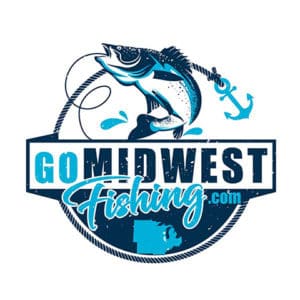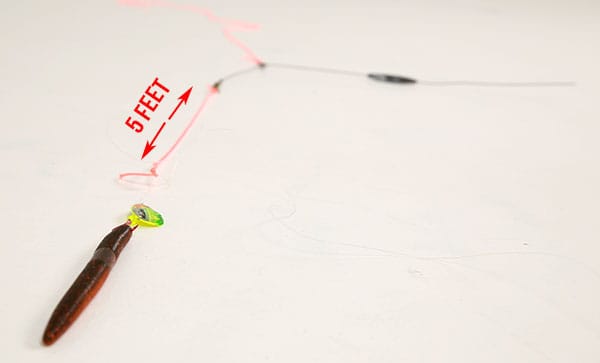The 2019 Minnesota Sportsman Show just happened here in St. Paul Minnesota. They have everything for fishing, camping, and hunting. In the upstairs section, they have a seminar room where professional fisherman talk about various topics. I attended one by Ted Takasaki called, “The Number One Technique For Walleye Angling Anywhere.”
According to Ted Takasaki, the number one technique for Walleye is a bottom bouncer with a night crawler rig.
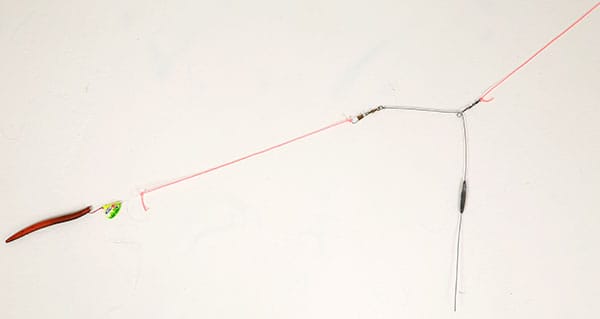
How to set up a bottom bouncer rig
The most important part of this rig is the bottom bouncer, because where the bottom bouncer is, that’s where your bait is going. They will come in several different weights. Generally a 1 ounce weight works well in 10 feet of water. Use a 2 ounce weight in 15-25 feet of water and a 3 ounce weight in 25-35 feet.

Use a 20lb braided line to a snap swivel. This way, if you get snagged, you can usually pull it free and at least get your bottom bouncer back, even if you loose your bait. It’s also thin enough in diameter to easily cut through the water. The connection point can vary depending on which one you buy. I personally like the ones with a closed loop, especially when using a snap swivel. Some are bent in an “R” shape and allow the snap swivel to slide down the wire.
The other end of the wire, the one without the weight will have a snap swivel too. This is where you will tie your line that goes to your bait. Start with about five feet of 12lb fluorocarbon connected to a night crawler rig.
The longer the line to the bait, the lower the bait will be to the bottom. If you find yourself getting snagged a lot, you can shorten this lead to as little as 3 feet.
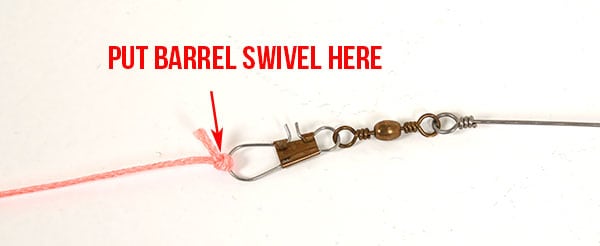
To make things easier, you can tie a barrel swivel to the line that goes to your bait, then just clip the other end to the snap swivel.
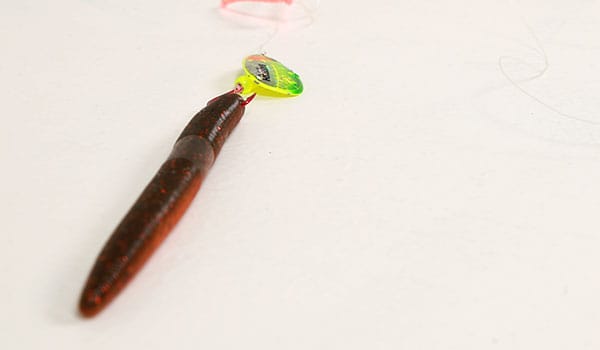
For night crawlers you will want a rig with two hooks. The first hook will go straight through the tip of the crawler, as shown in the picture. The other hook will go just behind the collar (Not shown). Make sure to leave some slack in the line to the second hook so the night crawler can stretch out.
A rig like the one shown, only has one hook. This one is good for attaching a leech or a minnow. Night crawlers work well for walleye most of the year, but they can be picky. Sometimes you need to switch up your baits until you find what they want on that particular day.
How To Fish a Bottom Bouncer
Angle is the key. You want your line at a 45 degree angle to the water. Boat speed should be between 1-1.5 mph. You should be able to feel when the spinner starts to grab with a, “thump-thump-thump.” So keep speeding up until you get that thump from the spinner blade then hold that speed.
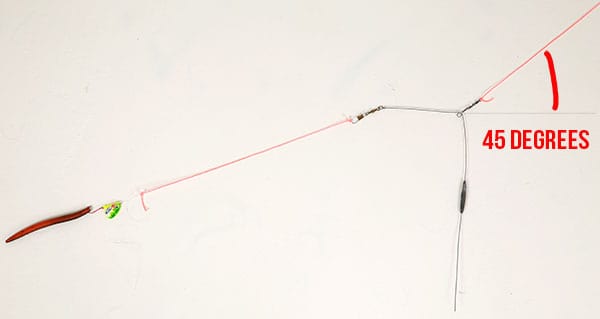
If your angle is less than 45 degrees, this means you are either going too fast, or you need a heavier weight. If you got the opposite problem of too large of an angle, then speed up or use a lighter weight.
Now to initially set up your line, first get your boat moving at around 1 to 1.5 mph, then release your line until it hits bottom. Put your finger on the line to stop it from going out. The bouncer should lift off the bottom again. Then release the line and when it hits bottom again, click your bail shut. Now you should be set at the right angle.
How To Locate Walleye’s
One thing is for sure. If there are no fish where you are at, you will not catch fish! So the most important thing to consider when fishing walleye, is to find where they are. Changing out baits and trying different speeds won’t do you much good if you didn’t find where they are hiding out first.
If you were a walleye, what would you be thinking about most of the day? That’s right, food! Walleye really have nothing better to do than to sit around thinking about what to eat next. So we need to fish where their food is. Where is their food? It’s in the stuff you get snagged on.
Lets talk about structure and cover. Structure is the stuff on the bottom, like rocks, sand and gravel. Cover is anything that grows or lays on top of the structure like, weeds or a dock. Now lets do a pretend experiment. Take a large rubbermaid tote, or a large aquarium, if you have one. Fill it with water and dump in a handful of minnows from the bait store.
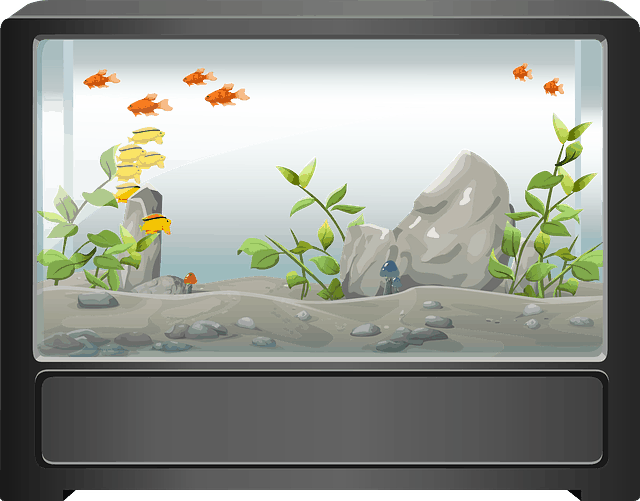
Where do you think the minnows will congregate? Most likely you will see them huddled in the corner. Now take a large rock and put it right in the center of the tank. What do you think will happen? The minnows will start to hide under or near the rock. Next, put in some sand or gravel, and put some plants in there. You can pick up some fake plants up at your local pet store. Now watch what the minnows do. You are going to find them hiding in, behind, or under all the items in the tank.
The combination of structure and cover concentrates fish.
Now if you get anything from reading this, it’s that you want to fish where there is structure and cover, because that’s what concentrates the minnows, so that’s where the walleyes are going to be.
One of the best places to find walleyes are on the points, but don’t neglect other places, like inside corners. Remember what happened in our tub experiment. When there was no structure or cover in the tank, the minnows huddled in the inside corners.
So now you’ve found some potential hot spots, but the fish aren’t biting. Now it’s time to offer them the food buffet. Give them a little bit of everything you got. If night crawlers aren’t working, try leeches or minnows. You can try jigs and crankbaits too. If different baits don’t work, try to vary your presentation. If you are doing a steady slow retrieve, try jerking the bait erratically. The important thing is to remember what you were doing just before you got the bite, then repeat that action.
You can listen to the seminar by Ted Takasaki by clicking below:
Conclusion
No matter where you are in the country, or what lake you are fishing, these techniques can apply anywhere. Just remember that walleye will be where the food is. The food (minnows) will be where there is structure and cover. Once you locate where their food source is, the next step is to get a bait in front of them. This can be accomplished with a bottom bouncer. Since walleye lay near the bottom, the bottom bouncer gets your bait down near the bottom where the fish are. If they are not in the biting mood, then switch up your baits and retrieval techniques.
I hope this information was helpful to you. I do like to catch walleye, but they are not the normal fish I target. Now I’m excited to go out and try some of these techniques to see if I can’t improve my walleye catch. Happy fishing!
I hope this article was useful. I have many more helpful and interesting articles, so please feel free to browse around and take a look. I’m also building a library of the best lake reviews on the web. Check back often, as I’m constantly adding new lakes.
Thanks for reading, and good luck out on the lake.
